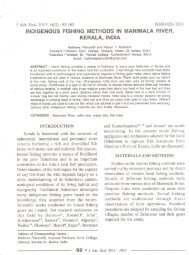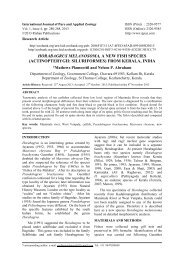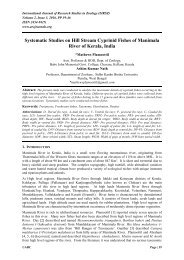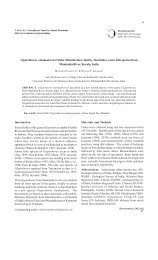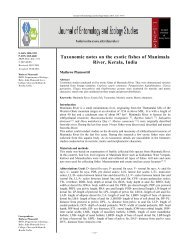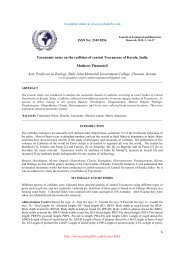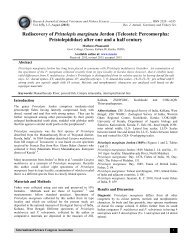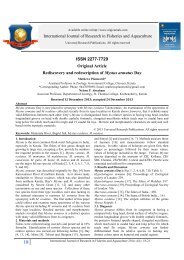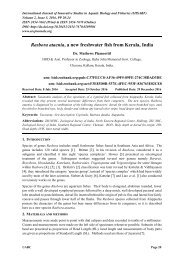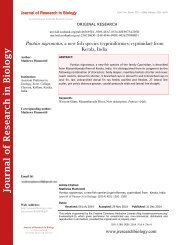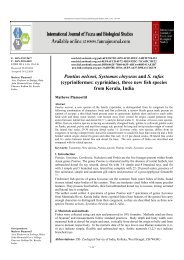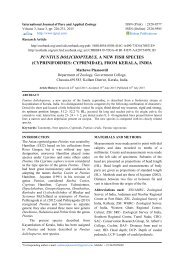Create successful ePaper yourself
Turn your PDF publications into a flip-book with our unique Google optimized e-Paper software.
Plamoottil, 2015<br />
vertical dark brown bars on head and body (vs. absent in<br />
the new species), and short based adipose dorsal fin (16.9<br />
-22.2 % SL vs. 25.0-29.0). <strong>Batasio</strong> convexirostrum<br />
Darshan et al., (2011) of Mizoram can be distinguished<br />
from the new species in having a pre dorsal bar (vs.<br />
absent in B. <strong>flavus</strong>), longer snout (39.2-45.5 % HL vs.<br />
31.3-38.0), very short inter dorsal distance (1.7-4.1 % SL<br />
vs. 8.0-12.3), long based adipose dorsal fin (31.0-34.9 %<br />
SL vs. 25.0-29.0) and pectoral fin with more branched<br />
rays (9-10 vs. 7-8). <strong>Batasio</strong> niger Vishwanath & Darshan<br />
(2006) of Manipur was considered as a junior subjective<br />
synonym of B. havmolleri by Ng & Kottelat (2007). The<br />
former differs from the new species in having a body<br />
with a black oblique pre dorsal bar (vs. absent in B.<br />
<strong>flavus</strong>), deeper body (BDA 18.4-24.8 % SL vs. 14.0-<br />
14.8) and higher head (16.7-22.3 % SL vs. 11.1-13.6).<br />
<strong>Batasio</strong> fasciolatus Ng (2006) of west Bengal can be<br />
differentiated from B. <strong>flavus</strong> in having 5-6 vertical dark<br />
brown bands (vs. absent in the new species), deeper body<br />
(BDA 18.1-20.3 % SL vs. 14.0-14.8), longer dorsal spine<br />
(13.6-16.8 % SL vs. 11.1-13.7) and smaller eyes (16.5-<br />
16.8 % HL vs. 23.5-28.1). <strong>Batasio</strong> spilurus Ng (2006) of<br />
Assam differs <strong>Batasio</strong> <strong>flavus</strong> in having a longer (26.9-<br />
28.6 % SL vs. 21.0-23. 8.), deeper (15.7-17.0 % S L vs.<br />
11.1-13.6) head and short based adipose dorsal fin (12.6-<br />
12.8 % SL vs. 25.0-29.0). <strong>Batasio</strong> fluviatilis (Day, 1888;<br />
Ng & Kottelat, 2007) differs from the new species in<br />
having a dark oblique predorsal bar and a dark spot on<br />
the sides of the body below the middle of the adipose-fin<br />
base (vs Absent in B. <strong>flavus</strong>) and a long based adiposefin<br />
(30.0-33.3 % SL vs. 25.0-29.0). <strong>Batasio</strong> tengana<br />
Hamilton (1822) of Brahmaputra River differs from B.<br />
<strong>flavus</strong> in having a dark mid dorsal stripe (vs. absent in B.<br />
<strong>flavus</strong>), elongated head (23.8-28.8 % SL vs. 21.0-23.8),<br />
shorter based adipose dorsal fin (14.5-17.5 % SL vs. 25.0<br />
-29.0) and slender caudal peduncle (DCP 6.7- 8.2 % SL<br />
vs. 8.6-11.6). <strong>Batasio</strong> batasio (Hamilton-Buchanan)<br />
(1822) of West Bengal have an elliptical dark brown spot<br />
below dorsal fin base (vs. absent in B. <strong>flavus</strong>), mottled<br />
pattern of faint brown patches on body (vs. absent),<br />
deeper head (16.3-21.2 % SL vs. 11.1-13.6), longer<br />
snout (43.9-46.2 % HL vs. 31.3-38.0), double (vs. single)<br />
cephalic fontanels and occipital process reaching basal<br />
bone of dorsal fin (vs. never reach).<br />
CONCLUSION<br />
<strong>Batasio</strong> species are obligate inhabitants of<br />
headwater streams and the upper reaches of smaller<br />
rivers characterized by fast-flowing, shallow, well<br />
oxygenated stretches of riffles and run broken up by<br />
pools or cascades in some cases. They prefer to live in<br />
small streams with rocky or sandy bottom. Taxonomic<br />
studies undergoing on these fishes are rare; it is mainly<br />
because they are not abundantly distributed in the large<br />
rivers where fishing practices are common; they are<br />
considered as weed fishes as they are not edible; as size<br />
is small they cannot be caught by the common gill nets<br />
and cast nets; their number may also be less. It was only<br />
in 1941 the first <strong>Batasio</strong> species discovered from Kerala.<br />
Now it is after 74 years a second <strong>Batasio</strong> species reaches<br />
to scientific world from Kerala. The new species,<br />
<strong>Batasio</strong> <strong>flavus</strong> is a unique <strong>Batasio</strong> species with many<br />
peculiar characters unseen in its congeners; they require<br />
spotless and clear water and are intolerant to the<br />
accumulation of organic wastes and other contaminants.<br />
Regular monitoring of the water quality is essential for<br />
the protection and preservation of this rare species.<br />
Comparative materials Examined<br />
<strong>Batasio</strong> travancoria: ZSI 13449/1, Holotype, 73.6 mm<br />
SL; India: Travancore, from the foot of the largest falls<br />
of Peruntenaruri, a tributary of the Pamba River at<br />
Edakadathy. 2 ex. 59.0, 65.0 mm SL, Kulathoopzha,<br />
Kallada River. ZSI 13452/1, 1 ex., 58.1 mm SL; India:<br />
Travancore, Palode, Chittar River.<br />
<strong>Batasio</strong> sharavatiensis: Holotype: ZSI/ SRC F 6419, 99<br />
mm SL, Joginmatha, Uttara Kannada, Karnataka, coll.<br />
Anuradha Bhatt, 08. 03. 1998. Paratypes: ZSI/ SRC F<br />
6420, 104.0 mm SL, Joginmatha, Sharavathi River,<br />
1806 Journal of Research in Biology (2015) 5(5): 1799-1808




